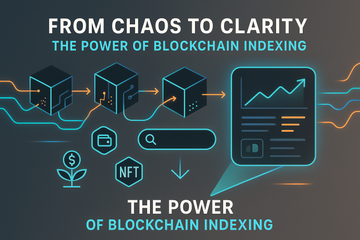Ever tried to find a needle in a haystack? Now, imagine that haystack is constantly growing and every straw is connected to a global money system. That, in a nutshell, is what poking around a blockchain can feel like—especially if you’re not using the right tools (or if your idea of data search is scrolling endlessly and hoping for the best). Blockchain indexing changes the game entirely, helping everyday crypto fans and hardcore developers surf that data ocean with a real boat, not just a paddle.
What Does Blockchain Indexing Even Mean?
Let’s cut through the technical jargon for a second. Blockchain indexing is how you turn that impossibly complex tangle of raw blockchain data into something that actually makes sense—something you can search, filter, and, well, use. It’s like putting street signs in a city where previously, directions were only passed by word of mouth. Suddenly, you know where you’re going (Ledger, 2024).
From Chaos to Clarity: Why Indexing Is a Big Deal
Blockchains are magnetic for data. Every transaction, every smart contract, every NFT—everything lives on-chain. That’s great for security and history, but not so great for actually finding something. Trying to check the history of a wallet, or track a DeFi movement without indexing? You’d be scrolling for days (or, honestly, just give up). Indexing serves as your super-organized librarian, labeling, cataloguing, and making sense of otherwise abstruse ledgers (QuickNode, 2024).
How Does Blockchain Indexing Actually Work?
Okay, let’s nerd out a little. Here’s the typical workflow:
- Nodes as the Source: Full nodes on a blockchain store all data. Light nodes keep it lite, focusing on headers and essential transactions. Indexers query these nodes, much like asking the main library to pull out every book published in 1998 (QuickNode).
- Parsers in the Middle: These digital translators skim through transactions, blocks, and contracts, pulling out the good stuff—wallet addresses, timestamps, contract logic, and more.
- APIs for Easy Access: Think of these as Google for blockchains. You get straightforward queries by address, transaction, or whatever metric you want.
- Databases that Actually Work: Indexers store this structured information in modern, query-friendly databases. Think Space and Time, or the backend magic behind most analytics dashboards (Space and Time).
Pocket-Sized Security: Indexing and Your Crypto Wallet
If you use a hardware wallet like Trezor or Ledger, you don’t see blockchain indexing at work directly—but you do feel its effects. When you check your balance, view incoming transfers, or monitor staking rewards, it’s indexing that fetches your data in a snap—no endless waits. These companies partner with leading indexers to ensure that your wallet experience stays quick, reliable, and accurate. Now, if you’ve ever compared Trezor and Ledger (and who hasn’t, at some point?) you know that fast, error-free data is a huge plus in both camps. Nobody wants to wait for their coins to show up, ever (Ledger).
Beyond Convenience: What Else Does Indexing Enable?
So, indexing is not just about speed or convenience; it unlocks innovation across the board:
- DeFi Monitoring: Real-time stats on liquidity pools or automated yield farms? That’s indexing behind the scenes.
- NFT Provenance: Want to check if your meme NFT was, in fact, minted by the legendary OG? Indexed data makes that clear as day.
- Regulatory Reporting: For the less-glamorous, but super-important, world of compliance, accurate indexed data keeps accountants and auditors smiling—or at least, less grumpy.
Spotlight: Space and Time (and Other Indexing Rockstars)
You know what? It’s not just the big exchanges or wallet-makers that care. Cutting-edge platforms like Space and Time, Bitquery, and Bware Labs are working quietly (well, not that quietly; they’re getting noticed) to build ultra-fast, cross-chain indexers. These solutions even let you run complex queries across multiple blockchains, making them the glue for hybrid dApps and analytics tools (Alchemy).
Without robust indexers, modern DeFi dashboards or multi-wallet portfolio managers wouldn’t even exist. The trend? It’s all about speed, cross-chain querying, and user privacy. We’ve come a long way from home-cooked scripts scraping block explorers in the night. Now, robust, almost industrial-grade indexers are the norm.
Is There a Downside? Let’s Get Real
Nothing’s perfect. Indexers add a layer of infrastructure, and sometimes, that means tradeoffs—centralization risk (if everyone uses the same third-party indexer) or even privacy concerns if improper data is cached or mismanaged. However, recent advances let many dApps and wallets use decentralized indexers or even roll their own lightweight indexers for extra security. The crypto community’s pretty vocal when something smells off, so things tend to improve fast.
What’s Hot in Blockchain Indexing Right Now?
This field moves fast. Lately, we’re seeing a surge in “indexing as a service,” letting smaller projects plug into pro-level data services. There’s also momentum for open-source, privacy-focused indexing solutions—think hybrid systems that blend on-chain and cloud storage for blazing speeds. And, with big brands like Ledger constantly improving the user experience, even the most security-conscious wallet users get the benefit.
Bringing It All Together
If blockchains are the future’s highways, then indexing is the signpost, the map, and the traffic reporter all rolled into one. Without it, we’re lost in the weeds, guessing at directions. With it, we discover, track, and shape the way forward—whether you’re securing savings with Trezor, trading NFTs, or dreaming up the next big DeFi protocol.
So, next time you’re checking your crypto with a smile, remember: there’s a whole unseen world making everything tick, and it’s called blockchain indexing. Bet you’ll never take that real-time balance update for granted again.











